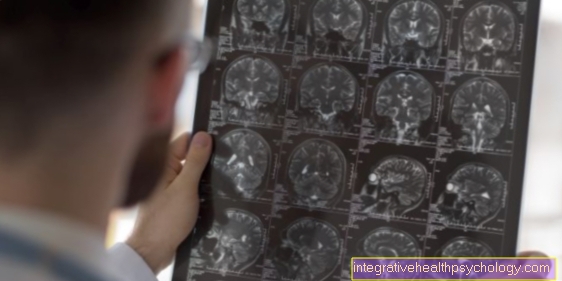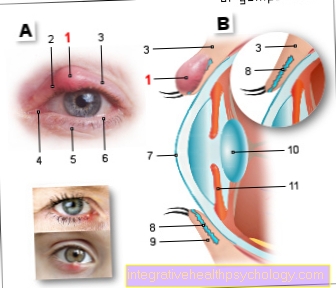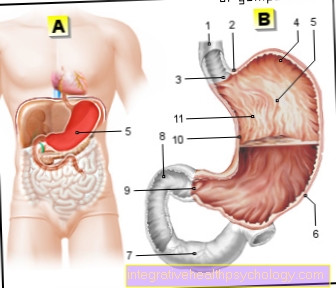Frontal sinusitis
introduction
In the case of a frontal sinus infection (Frontal sinusitis) it is a painful illness, which is mainly characterized by enormous and prolonged headaches (Cephalgia) expresses. The frontal sinus infection is counted among the sinus infections and occurs mainly in adult patients as the frontal sinuses have to be fully developed in children.
Is Sinus Infection Contagious? Find out more at How contagious is a sinus infection
causes

Sinusitis can have several causes. Acute frontal sinusitis can develop from a cold. With a cold it happens that the mucous membranes in the nose become irritated and swell. On the one hand, this leads to an annoying runny nose, on the other hand it leads to a build-up of secretion. This means that the liquid, which normally comes out of the nose, is hindered from exiting, and at the same time hardly any air can enter the frontal sinus to ventilate and cleanse it.
If a patient does not treat his cold with the accompanying runny nose adequately or not at all, it can happen that the secretion of the nose cannot transport the contained pollutants, viruses or bacteria to the outside. Instead, the secretion is stored in the frontal sinuses and is the ideal place for bacteria to multiply and release harmful substances. Thus, the runny nose can indirectly lead to an inflammation of the frontal sinus.
However, not every cold leads to a frontal sinus infection. Above all, anatomical circumstances favor the process. There are patients who have very narrow paranasal sinuses, which means that the secretion can accumulate much more easily than in patients with wide frontal and paranasal sinuses. A curvature of the nasal septum, for example after a broken nose or due to congenital circumstances, restricts the outflow of secretion and thus promotes frontal sinusitis.
Many patients suffering from chronic rhinitis due to an allergy are familiar with the problem of frontal sinus infections. Due to the permanent irritation of the nasal mucous membrane, a lot of "old" secretion remains in the nose and can therefore collect in the frontal sinus. This very often leads to frontal sinus infections in allergy sufferers. Patients with an allergy to grass and / or pollen are particularly affected.
Nasal polyps (Polyposis nasi) can lead to a frontal sinus infection. Nasal polyps are mucous membrane growths that either arise in the nose and then hinder the discharge of secretions or directly in the frontal or paranasal sinuses.
In rare cases, tooth root inflammation also leads to frontal sinusitis. The reason for this is a direct connection between the mouth area and the paranasal sinuses and thus also the frontal sinus. However, with rapid treatment, tooth root inflammation rarely spreads to the frontal sinus.
Frequency distribution
A frontal sinus infection occurs mostly in patients with particularly narrow sinuses or Nasal septum wall defects on.
At young children or infants it is only very rarely to be found because they still have to completely develop their frontal sinus and very little secretion can deposit there beforehand. Still, it can be especially after Otitis media Frontal sinus infections can also occur in young children.
diagnosis
To the diagnosis To confront a frontal sinus infection, it first requires an extensive one Doctor-patient conversation, so one anamnese. In addition, the doctor can take a blood sample to determine if an acute bacterial or viral inflammation present.
In addition, the nose can be examined from the inside, this process is called Rhinoscopy. The doctor uses a thin tube that is inserted into the nose. Over a camera the nose can then be viewed precisely on a monitor and the correct diagnosis can be made.
Instead of taking a blood sample, a Nasal swab be made to determine which pathogens cause the runny nose and thus usually also the frontal sinus infection. In rare cases, especially with chronic frontal sinusitis, can also be a X-ray or one Computed Tomography (CT) Recordings must be made in order to use the images to see whether there is still secretion in the frontal sinus and thus responsible for the inflammation.
Symptoms
The Symptoms a frontal sinus infection occur in every patient different intensity on. Yet there are many similarities. For one, it is typical to have a frontal sinus infection after a cold or as a result of the allergy occurs. The patient has usually been long-lasting sniff and in addition the constant feeling that the nose is blocked and there is no possibility of complete relief. Often the nose is completely closed and the patient finds it difficult to breathe through the nose, which then happens at night snoring leads. In addition, there may be purulent, in rare cases slightly bloody discharge from the nose.
The pus arises from the bacteria, Bleeding can occur when small veins tear in the nose due to constant blowing of the nose. It is also typical that it becomes stronger Headache (Cephalgia) especially in the forehead area. However, the pain can also affect the Area behind the eyes spread. In addition to the pain, there is also a strong feeling of pressure. A feeling of pressure and pain can occur when you shift your weight forward, for example when you bent over in front sit, gain weight. If you leave a frontal sinus infection untreated for a long time, the inflammation can worsen and it can also fever, Swelling and Visual disturbances come. At the latest with these symptoms you should urgently consult a doctor.
therapy
A adequate therapy in the case of a frontal sinus infection it is strongly recommended and should speak to your family doctor or ear, nose and throat doctor (short ENT) to be discussed.
With a mild frontal sinus inflammation, it is often enough Nasal sprays off, however, these should no longer than 7 or 8 days otherwise Addictive potential consists.
In drugstores, however, you can often find nasal sprays, which Saline solutions contain. These are harmless, but only have a sufficient effect in the early stages of a frontal sinus infection.
So are better Inhalations. Especially Salt water solutionsthat are inhaled for several minutes can help the patient because the nasal mucous membrane swells and the secretion can drain away.
There are also a few here Home remedies which one can use. One of the best home remedies is this Inhaling and inhaling bathswhich for example essential oils contain. Chamomile baths or baths with thyme help with frontal sinus infections. Also the essential oils myrtle are particularly beneficial, but you can also take them in capsule form as they also have an anti-inflammatory effect in this way.
Another home remedy that can help with sinusitis is that Primate root. You can buy this in the pharmacy and then add it to the tea in small pieces. The primate root liquefies the secretion in the nose and can thus fight the cause of the frontal sinus infection directly.
Besides the home remedies, there are also synthetic expectorant drugswhich can be used, especially if they have a decongestant effect in addition to the secretion-liquefying effect.
If the frontal sinus infection is bacterial and advanced, it should be treated with Antibiotics to be thought about. After a while, there may be many bacteria have accumulated in the frontal sinus, which cannot be treated with inhalations or nasal sprays. Then it is advisable to use antibiotics.
Especially when the discharge from the nose becomes purulent, it suggests that there is an infection with the bacteria of the class Staphylococci or Streptococci present. After swabbing the nose, the doctor knows exactly which bacterium is causing the sinus infection and which antibiotic this bacterium is resistant to. In this case, adequate antibiotic therapy can be started, and the patient can continue to inhale baths or use nasal sprays.
prophylaxis
A frontal sinus infection is common only difficult to avoid, especially if the patient has particularly narrow sinuses or a Nasal septum defect suffers.
It is therefore particularly important for these patients to cure every cold and runny nose sufficiently. Inhalations can help and have a decongestant effect. In addition, the patient should drink a lot to promote blood circulation. It is especially important at this time not to exercise otherwise the inflammation is directed using the bloodstream heart can spread.
Forecast and doing sports
A sinus infection has a very good prognosis as long as the patient adheres to the therapy of the doctor holds.
It is also important that during the frontal sinus infection but also during the Cold no sport is operated! Many patients underestimate the risk involved. A frontal sinus infection that is bacterial or viral must always be accompanied by an absolute ban on exercise, as the germs spread through the bloodstream Spread out towards the heart can and, in the worst case, you can become one even after years Inflammation of the heart being able to lead (Endocarditis), which then with a very high complication rate and is not infrequently associated with death. Therefore, after consulting the doctor, the patient should not do any sport during the treatment period, unless the doctor considers this to be problem-free. Once the frontal sinus infection has been reduced, it is no problem to start exercising.





























